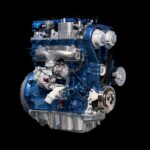
Ford Fiesta Check Engine Light: Complete Diagnostic & Repair Guide

When the Check Engine light illuminates on your Ford Fiesta, it's more than a dashboard nuisance—it’s the vehicle’s electronic control system warning you that something isn’t functioning as expected. As specialists in Ford diagnostics, we’ve developed a comprehensive, deeply detailed, and SEO-optimized guide that surpasses generic advice and equips you with precise, actionable insights tailored specifically to the Ford Fiesta.
- What the Check Engine Light Means on a Ford Fiesta
- Primary Causes of Check Engine Light in a Ford Fiesta
- Fiesta-Specific Reported Cases (Real Owner Scenarios)
- How to Diagnose the Check Engine Light (The Right Way)
- Step-by-Step Diagnostic Workflow
- Most Common Diagnostic Trouble Codes (DTCs) for Ford Fiesta
- When the Fiesta Enters Limp Mode
- How to Fix the Check Engine Light on a Ford Fiesta
- Prevention Tips for Ford Fiesta Owners
- Final Thoughts
- FAQs
- 1. Can I drive my Ford Fiesta with the Check Engine light on?
- 2. Why does my Fiesta lose power when the light turns on?
- 3. Will a failing catalytic converter trigger the Check Engine light?
- 4. Can a loose fuel cap cause the Check Engine light in a Fiesta?
- 5. Do I need a specific scanner for Ford vehicles?
What the Check Engine Light Means on a Ford Fiesta
The Ford Fiesta is equipped with an ECU (Engine Control Unit) that continuously monitors sensors, actuators, combustion efficiency, and emissions. When any parameter falls outside the expected range, the ECU triggers the Check Engine (MIL – Malfunction Indicator Lamp) to signal a malfunction.
The nature of the light tells you the severity:
Indicator States & Severity Levels
- Solid Check Engine light → A fault is present but not immediately catastrophic.
- Flashing Check Engine light → Severe misfire or major fault; driving may cause engine or catalytic converter damage.
- Light that flashes and then disappears → An intermittent fault was logged but is not currently active.
- Dual-color indicators (rare in some markets)
- Yellow → Non-critical issue
- Red → Critical ECU-detected malfunction
Primary Causes of Check Engine Light in a Ford Fiesta
Over years of field diagnostics and thousands of Fiesta-specific repairs, these are the most common triggers:
1. Misfires (Cylinder Misfire / Ignition Failure)
A misfire occurs when one or more cylinders fail to combust properly. It is the single most common cause of a flashing Check Engine light in the Fiesta.
Typical symptoms:
- Rough idle
- Loss of power under load
- Vibrations
- Flashing MIL
Most frequent culprits:
- Faulty spark plugs
- Worn ignition coils
- Damaged coil pack wiring
- Injector malfunction
2. Faulty Oxygen Sensor (Lambda Sensor)
The Fiesta uses oxygen sensors to adjust air-fuel ratio. A failing O2 sensor causes poor combustion and triggers the MIL.
Related symptoms:
- Jerking when accelerating
- Poor fuel economy
- Hesitation at low RPM
- Light may flash under heavy throttle
Additional risks:
- A failing sensor can overwork or damage the catalytic converter.
3. Catalytic Converter Inefficiency
The Fiesta's catalytic converter is sensitive to misfires, oil burn, and incorrect fuel mixture.
Signs include:
- Lack of power
- Strong sulfur smell
- High operating temperature
- Persistent Check Engine when accelerating
Catalytic damage is expensive and often follows unresolved misfires.
You may be interested in reading Ford Fiesta Engine Size Guide: Complete Specs, Horsepower, Torque & Oil Capacity by Year
Ford Fiesta Engine Size Guide: Complete Specs, Horsepower, Torque & Oil Capacity by Year4. Air or Fuel Delivery Problems
The Fiesta is particularly prone to fuel delivery inconsistencies and intake air issues.
Causes:
- Clogged fuel filter
- Failing fuel pump
- Dirty throttle body
- Vacuum leaks
- MAF sensor contamination
Resulting symptoms:
- Power loss when accelerating
- Low idle RPM
- Engine stalling
- Hesitation or jerking
The Fiesta’s wiring harness, especially around the engine bay, is known to present intermittent faults.
Common issues:
- Broken wires
- Corroded connectors
- Grounding faults
- Short circuits
Electrical issues often cause intermittent Check Engine illumination and multiple random error codes.
6. Sensor Failures (General)
Besides the oxygen sensor, the Fiesta relies heavily on:
- MAP sensor
- Crankshaft position sensor
- Camshaft sensor
- Temperature sensor
- TPS (Throttle Position Sensor)
Any malfunctioning sensor can place the vehicle into limp mode (reduced power mode).
7. Wiring & Connector Problems
False contacts and damaged connectors are recurring problems in Fiesta models from 2008–2017.
Typical signs include:
- Speedometer failure + Check Engine
- Multiple warning lights at once
- Loss of power combined with instrument cluster issues
Fiesta-Specific Reported Cases (Real Owner Scenarios)
1. Speedometer Stops Working + Check Engine
- Model: Fiesta 2011 1.6
- Symptoms: Speedometer dead, engine feeling “choked,” loss of power
- Likely cause: Vehicle speed sensor failure or cluster wiring fault
2. Yellow Engine Light Flickering Under Acceleration
- Model: Fiesta 2011 Ambiente
- Symptoms: Continuous flicker when accelerating
- Likely cause: Ignition misfire or failing coil packs
3. Wrench Light + Check Engine + Rattling Noise
- Model: Fiesta 2017 SE Manual
- Symptoms: Loss of power, metallic rattling near throttle body
- Likely cause: Throttle body actuator fault, early timing belt problems, or detonation
4. Check Engine After Coolant Cap Replacement
- Model: Fiesta 2008
- Symptoms: MIL came on after coolant reservoir cap change
- Likely cause: Sensor triggered due to pressure imbalance, incorrect cap specification
How to Diagnose the Check Engine Light (The Right Way)
Scanning the vehicle is essential. Blind troubleshooting leads to unnecessary repairs.
You may be interested in reading Ford Fiesta Engine Size Guide: Complete Specs, Horsepower, Torque & Oil Capacity by Year
Ford Fiesta Engine Size Guide: Complete Specs, Horsepower, Torque & Oil Capacity by Year How to Change a Ford Fiesta Headlight Bulb (Complete Step-by-Step Guide)
How to Change a Ford Fiesta Headlight Bulb (Complete Step-by-Step Guide)Step-by-Step Diagnostic Workflow
- Read stored and pending codes using an OBD2 scanner compatible with Ford modules.
- Check live data (fuel trims, O2 sensor values, MAF readings, coolant temps).
- Inspect ignition components (coils, plugs).
- Verify wiring continuity across known weak points.
- Check vacuum lines for leaks.
- Test fuel pressure and injector response.
- Perform a throttle body adaptation reset if necessary.
Most Common Diagnostic Trouble Codes (DTCs) for Ford Fiesta
| Code | Meaning | Most Likely Cause |
|---|---|---|
| P0300–P0304 | Cylinder misfire | Coils, plugs, injectors |
| P0130–P0141 | O2 sensor faults | Lambda sensor, catalytic issues |
| P0171 | System too lean | Vacuum leaks, MAF, fuel pump |
| P0420 | Catalyst efficiency low | Catalytic converter degradation |
| P0606 | ECU processor fault | ECU internal malfunction |
| P0500 | Vehicle speed sensor | VSS failure, wiring |
| P2111/P2112 | Throttle body stuck open/closed | Throttle actuator issues |
When the Fiesta Enters Limp Mode
A severe fault forces the ECU into reduced power mode, preventing engine RPM from exceeding a safe threshold.
Common triggers include:
- Severe misfires
- Throttle body failure
- Crankshaft/camshaft sensor issues
- Overheating
- Transmission-related faults
Driving long distances in limp mode can worsen the underlying problem.
How to Fix the Check Engine Light on a Ford Fiesta
- Replace spark plugs
- Replace ignition coils
- Repair damaged wiring
2. Replace or clean faulty sensors
- Lambda (O2) sensor
- MAF sensor
- MAP sensor
- Crankshaft/camshaft sensor
3. Repair air intake or vacuum issues
- Replace cracked hoses
- Clean throttle body
4. Repair fuel system components
- Replace fuel filter
- Fix weak fuel pump
- Clean or replace injectors
5. Resolve catalytic converter problems
- Address the root cause (misfire) first
- Replace converter if internal damage is confirmed
6. Correct wiring & ECU faults
- Repair harnesses
- Clean corroded connectors
- In rare cases, reprogram or replace ECU
Prevention Tips for Ford Fiesta Owners
- Replace spark plugs on time
- Use high-quality fuel
- Clean the throttle body every 20,000–30,000 miles
- Avoid running the engine on low fuel
- Perform regular OBD scans
- Fix misfires immediately to protect the catalytic converter
Final Thoughts
The Check Engine light in a Ford Fiesta can signal anything from a simple loose connector to a serious misfire capable of damaging the engine. With a precise diagnostic approach, the exact cause can be identified quickly, minimizing repair costs and preventing long-term issues. This guide empowers Fiesta owners and mechanics with the detail, clarity, and technical depth necessary to resolve the problem efficiently.
FAQs
1. Can I drive my Ford Fiesta with the Check Engine light on?
Yes, if the light is solid. No, if it is flashing.
2. Why does my Fiesta lose power when the light turns on?
The ECU may activate limp mode due to misfires, sensor faults, or throttle body issues.
3. Will a failing catalytic converter trigger the Check Engine light?
Yes—codes like P0420 indicate catalyst inefficiency.
4. Can a loose fuel cap cause the Check Engine light in a Fiesta?
Less common than on other brands, but possible.
5. Do I need a specific scanner for Ford vehicles?
Using a scanner that supports Ford-specific protocols yields more accurate diagnostics.
You may be interested in reading Ford Fiesta Engine Size Guide: Complete Specs, Horsepower, Torque & Oil Capacity by Year
Ford Fiesta Engine Size Guide: Complete Specs, Horsepower, Torque & Oil Capacity by Year How to Change a Ford Fiesta Headlight Bulb (Complete Step-by-Step Guide)
How to Change a Ford Fiesta Headlight Bulb (Complete Step-by-Step Guide) How to Change a Brake Light on a Ford Fiesta (Step-by-Step Expert Guide)
How to Change a Brake Light on a Ford Fiesta (Step-by-Step Expert Guide)If you want to know other articles similar to Ford Fiesta Check Engine Light: Complete Diagnostic & Repair Guide you can visit the category Service and Parts.
Deja una respuesta




More content of your interest